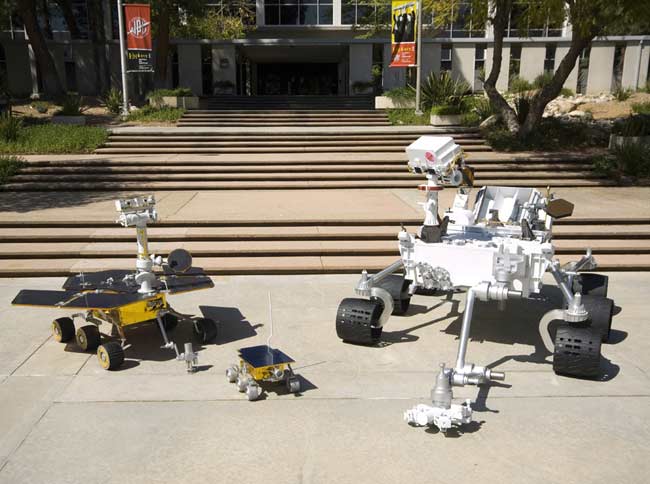Future of Mars Exploration: What's Next?

Now thatNASA's Phoenix Mars Lander is settled in on the arctic plains of Mars, takingpictures and starting to gather samples, space agencies all over the world areplanning and building the next robots and gadgets they plan to send to probethe mysteries of the red planet.
NASA plansto waste no time in getting back to Mars after Phoenix finishes its three-monthmission. By September or October of next year, launch is set for the MarsScience Laboratory, a beefed-up rover that will further explore the Martiansurface (it will be the largest vehicle ever sent to Mars).
And Americanswon't be the only ones visiting the red planet: The European Space Agency (ESA)is currently working on its own rover, dubbed ExoMars, which would be equippedto scout out signs of past or present life on Mars. The Chinese and Russianspace agencies are also collaborating on a mission to the planet'sasteroid-like moon, Phobos.
Mega-rover
The MarsScience Laboratory (which won't be the craft's final name) will be much largerthan its Mars Exploration Rover (MER) cousins, Spirit and Opportunity,which are currently still cranking around the Martian surface. The"mega-rover" will weigh in at about 2,040 pounds (925 kg) ? sort ofthe monster truck of Mars rovers.
This heftysize should allow the rover to take more instruments to Mars to poke and prodthe surface ? the payload will be about 10 instruments to be exact, weighing inat a total of 154 pounds (70 kg). Like other Mars landers and rovers before it,MSL will of course have cameras to snap pictures of the Martian landscape andhelp guide its six wheels across the terrain. One camera, the Mars Hand Lens Imager,will take extreme close-up shots of the surface.
But unlikethe MERs, which were like geologists on Mars, MSL is designed to be more of achemist. One MSL tool, called ChemCam, will be new to Mars. It is a laser thatcan be used to zap Martian rocks to create a fine dust that it can then analyzeto determine the rock's composition. These scans should help scientistsdetermine what to take a closer look at.
Breaking space news, the latest updates on rocket launches, skywatching events and more!
"If welike that rock, we get up close and personal with that rock," said Fuk Li,manager of the Mars Exploration Program at NASA's Jet Propulsion Laboratory,where MSL is being designed and assembled.
The rovercan do this with its drill, which can suction onto a rock, bore down into it,and extract a sample of the powder to be analyzed by the instruments inside therover, including an Alpha Particle X-ray Spectrometer, the Sample Analysis atMars instrument and an X-ray diffraction and fluorescence instrument calledCheMin.
The rover'ssize will also enable it to venture further across the Martian landscape, up to12 miles (20 kilometers) from its landing site, which it is projected to reachsometime during July 2010.
The wheelsover the rover, which will be attached to long, spindly legs, will enable thevehicle to roll over rocks if it needs to, "but the fact that we can climbover the rocks doesn't mean we want to on Mars," Li said, because of thepossible damage they could do to the craft.
Go, go'Sky Crane'
With theproposed launch date just a little more than a year away, engineers at JPL areworking to get the craft, which is among the biggest they have ever assembled,ready in time.
"We'rein the middle of putting the spacecraft together," Li said, likening thejob to "a three-dimensional jigsaw puzzle."
The MSLteam has finished the wheels and deck of the rover and are working on buildingthe avionics and computer power distribution system that will go inside andhelp run the vehicle. The incomplete rover is affectionately referred to as the"Scarecrow."
"It hasno brain, that's why they call it the Scarecrow," Li said.
Whereexactly MSL will land has yet to be determined. NASA has its MarsReconnaissance Orbiter looking at six candidate sites within 30 degrees northand south latitude of the equator.
To get toits landing site,wherever that ends up being, MSL will have a cruise stage to guide it to Mars,similar to other spacecraft, a heat shield to protect it during its initialdescent, and a parachute and back shell that will separate from the craft duringits descent, also like other Martian probes.
But afterthis stage, MSL will use a completely newway of touching down on the surface, with a system called Sky Crane. TheSky Crane will have cords that attach it to the lander. As the rover falls tothe surface, the Sky Crane's thrusters should slow their descent and then"very, very, very slowly," it will lower the rover down with thecords, Li said.
As this ishappening, the rover unfolds its wheels. When these touch the surface, the SkyCrane senses, "Aha! I've landed," Li said, and detaches its cordsfrom the rover and flies away and crashes on the surface.
The missionis slated to last for two Earth years (one Martian year). While Spirit andOpportunity have lasted far longer than their three-month-long planned mission(and are still kicking), Li and other NASA scientists aren't counting on MSLlasting longer, because like both MERs, the mechanical joints of MSL willeventually wear down with age.
"We'redesigning it to last two years," Li said.
Mission to the moon
TheEuropean Space Agency (ESA) is also planning their own rover that would beaimed at looking for extinct or current life on Mars.
Dubbed ExoMars,the 650 million euro ($876 million) mission would include instruments,including a few from the United States, aimed at characterizing the Martianbiological environment. One of the planned instruments is a drill that couldbore into the terrain to about 8 feet (2.5 meters) below the surface, which hasnever been done before on Mars.
ExoMars iscurrently slated to lift off in 2013 aboard either a European Ariane 5 rocketor a Russian Proton rocket. It would include an orbiter to relaycommunications, a descent module and a rover. The rover would land either usingan inflatable breaking system or parachute system.
ESA isplanning to power the rover using solar arrays. The rover would be able totravel a few kilometers over the Martian surface, navigating autonomously usingoptical sensors.
The Chineseand Russian space agencies are also currently planning a Martian mission, buttheirs will be aimed at one of Mars' two moons, Phobos. Russia last tried to reach the tiny satellite with its Phobos-1 and Phobos-2 probes, whichwere lost in 1988 and 1999, respectively.
The new Phobos-Gruntprobe, currently being built at Lavochkin Scientific Production Associationin Khimki, Russia, would launch in 2009. The anticipated three-year-longmission aims to deliver rocks from Phobos back to Earth, map the surface of thesatellite and analyze the plasma and dust that surrounds it.
Of coursethese steps are only just the next of many steps in exploring our ruddyneighbor. Eventually, both NASA and the ESA hope to return samples of Mars'red-orange rocks and one day send humans to take the first actual step on theplanet.

Andrea Thompson is an associate editor at Scientific American, where she covers sustainability, energy and the environment. Prior to that, she was a senior writer covering climate science at Climate Central and a reporter and editor at Live Science, where she primarily covered Earth science and the environment. She holds a graduate degree in science health and environmental reporting from New York University, as well as a bachelor of science and and masters of science in atmospheric chemistry from the Georgia Institute of Technology.
